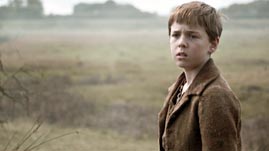Teachers' Domain - Digital Media for the Classroom and Professional Development
User: Preview


Source: MASTERPIECE: "Great Expectations"


MASTERPIECE is funded by Viking River Cruises, with additional support from public television viewers, and contributors to The Masterpiece Trust, created to help ensure the series’ future.
This video excerpt is the opening scene from the 2012 MASTERPIECE adaptation of Charles Dickens's Great Expectations. A man mysteriously emerges from a marsh to ominous music. A young boy, Pip, is shown briefly in a church graveyard, reading the sad gravestone of his parents and five brothers and sisters. Suddenly frightened, Pip runs off, but not to safety. Instead, he goes towards the marsh, right into the path of the hulking escaped convict Abel Magwitch, who is coated with grime and mud. Magwitch grabs Pip. "Scream again," Magwitch says to Pip, "and I’ll cut your throat."
Great Expectations by Charles Dickens: Chapter I (Document)
Great Expectations is one of Charles Dickens's most famous novels. Generally viewed as a bildungsroman (coming-of-age story), it is the tale of how the young boy Pip rises from his seemingly lowly status as a poor orphan to become a young gentleman of means. Much to his amazement, Pip is chosen by the wealthy recluse Miss Havisham to be a companion to her adopted daughter, the beautiful but cruel Estella. This begins not only his education, but his sense that his future might be brighter than he had dared to hope. An even greater surprise awaits several years later: he is told he has an anonymous benefactor who will pay for Pip to go to London and become a gentleman. Pip, it seems, is a "young fellow of great expectations."
Written in 1860–1861, Great Expectations was Dickens's 13th novel. Many critics compare it to David Copperfield, written ten years earlier. Both are semi-autobiographical, and concern a young boy who begins in miserable circumstances and achieves, if not happiness, wisdom and maturity in the end. Like Dickens, Pip hates injustice. "…there is nothing so finely perceived and so finely felt," he says, "as injustice…Within myself, I had sustained, from my babyhood, a perpetual conflict with injustice." Great Expectations, however, is much darker than David Copperfield, and reflects the author’s own realization that “success” does not necessarily bring joy. As writer Sarah Phelps, who adapted this 2011 MASTERPIECE film version of Great Expectations, says, "Great Expectations is…an epic story about obsession, corruption, revenge, redemption and forgiveness. It is dark and complex, with the shadow of the gallows always present, but beating throughout is the passionate human heart. Ultimately, it is a story of what we will do, what we will risk, and just how far we will go for love."
Dickens's books are filled with vivid descriptions, colorful dialogue, memorable characters, drama, suspense, and deep reflections on the meaning of love, happiness, pride, wealth, vice, and virtue. Not surprisingly, Dickens's novels have been made into countless films. Great Expectations has had at least nine film and television versions, including a 1917 silent film, a well-known 1946 version directed by David Lean, and a previous MASTERPIECE adaption, which aired in 1999.
Turning a novel into a screenplay—and then creating the actual film with sets, costumes, actors, music, lighting, and so on—is not just a matter of pulling characters, setting, and dialogue from the printed page. For some, film brings literature alive and allows access to a work whose language may be challenging to read or understand. Although film does not allow us to interact with the plot or characters by imagining them in our minds, even skilled readers may enjoy or prefer a filmmaker’s interpretation. Yet, film can also be limiting; for one thing, there are no time constraints on a novel, while a film must generally compress events. For another, a novel is controlled by only one person—the author—while the meaning we get from a film is the result of a collaborative effort by a large number of people.
How faithful to the original written work should a film version strive to be? In his 1992 book Reading the Movies, William Costanzo quotes George Bluestone, one of the first to study film adaptations of literature. Bluestone believes the filmmaker is an independent artist, "not a translator for an established author, but a new author in his own right." The filmmaker has to refashion the spirit of the story with his or her own version and tools.
Sarah Phelps, who had to take 700 pages of text and fit it into a 3-hour film, has said about Great Expectations, "You want to hit the ground running. It’s a great story. Let’s get on with it!" Consider the choices she, as well as the director Brian Kirk, have made in the opening scene—one of the most memorable in all of Dickens’s novels.
The beginning of a Dickens novel is always memorable. By watching this video excerpt, students can explore the choices the filmmakers have made to set the scene in which young Pip first meets the escaped convict Abel Magwitch. They then can read the original text by Dickens and compare and contrast it with the film. After discussing the similarities and differences, they can reflect on what is gained and what is lost in adapting classic literature to film.
This resource may be best used as students begin their unit on Great Expectations, so that they come to the opening scene without preconceived notions.
Before watching the video:
While watching the video:
After watching the video:
For more about how to use MASTERPIECE to help you teach Charles Dickens, see the MASTERPIECE Teacher’s Guides, which contain discussion questions, activities, and background information. Teaching Dickens explores Oliver Twist, David Copperfield, Little Dorrit, and The Old Curiosity Shop. An individual guide is provided for A Tale of Two Cities. You may also wish to use the resources in the Charles Dickens Book and Film Club.
 Loading Standards
Loading Standards